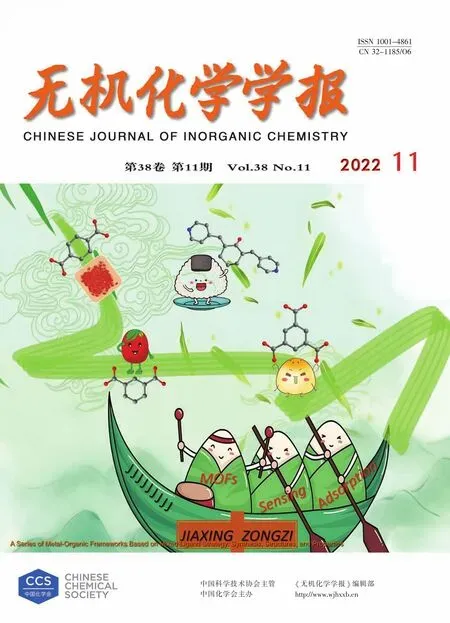卤氢键桥联的铁(Ⅲ)配合物呈现出高于室温的自旋交叉行为
卫晓琴 高 转 任 帆 崔晓友 周 悦 邵 东*,,3
(1晋中学院材料科学与工程系,山西省轻质材料改性应用协同创新中心,晋中 030619)
(2黄冈师范学院化学化工学院,催化材料制备及应用湖北省重点实验室,黄冈 438000)
(3南京大学配位化学国家重点实验室,南京 210023)
0 Introduction
The spin crossover(SCO)complex is one of the most attractive molecular materials showing magnetic bistability,which has potential applications in molecular switches,sensors,and display devices[1-2].Due to their inherent electronic switching between high-spin(HS)and low-spin(LS),this fascinating physical phenomenon can also be used to control other physical properties via temperature,pressure,light irradiation,or magnetic field[3].The most important index for an SCO complex is the performance of its spin transition temperature(T1/2)and thermal hysteresis loop width(ΔT).Generally,SCO materials with 30-50 K hysteresis loops centered around room temperature regions are of great importance and widely pursued[4].Over the past eight decades,great endeavors have led to many SCO complexes that exhibit various metal centers,molecular structures,and spin bistabilities.However,SCO complexes with room-temperature magnetic bistability are very rare,and the design and construction of highperformance SCO molecules remain challenging[5-7].To obtain cooperative SCO property,strong cooperative interactions that act on the SCO metal sites are of great significance,which usually can be achieved through covalent bonding or supramolecular intermolecular interactions,such as hydrogen bonding,π-π interactions,and halogen bonding[8-12].Thus,the key development of hysteretic SCO materials is to understand and explore the crystal engineering of efficient supramolecular intermolecular interactions.
Compared with widely studied Fe(Ⅱ)SCO systems,Fe(Ⅲ)complexes become more and more attractive because of their higher air stability,which is vital for practical application[13-15].To date,there are several Fe(Ⅲ)SCO complexes constructed usually by mixed N/O/S coordination donor sets,such as N4O2,N3O2S,and N2O2S2[13].In stark comparison,N6coordination environments for Fe(Ⅲ)SCO complexes are very rare.To access N6FeⅢSCO complexes,2,6-bis(benzimidazol-2-yl)pyridine(bzimpy)is a suitable choice[16-21].In fact,this ligand has a fascinating variability in both the chemistry and SCO properties for FeⅡ/Ⅲcomplexes.Though several bzimpy-based FeⅡSCO complexes have been reported,FeⅢSCO complexes have not been reported so far[17-21].As can be seen in Fig.1,there are two protons in the ligand and thus bzimpy can be deprotonated affording bzimpy-1H and bzimpy-2H.These structural characteristics potentially provide the chance to take advantage of the two protons for the engineering of hydrogen bonding interactions and controlling ligand valence via deprotonation.Considering the high interest in both Fe(Ⅲ)SCO complexes and supramolecular control on intermolecular interactions,we aim to develop new Fe(Ⅲ)SCO complexes involving interesting supramolecular interactions.

Fig.1 Molecular structures of ligand bzimpy,and its deprotonated species bzimpy-1H and bzimpy-2H
With the above aspects in mind,a mononuclear Fe(Ⅲ) complex,[FeⅢ(bzimpy-1H)2]Cl(1),has been synthesized based on the tridentate chelate ligand bzimpy.Interestingly,the complex is solvent-free and possesses a halogen hydrogen-bonded supramolecular network where the Fe3+center locates in a distorted N6octahedral coordination environment.Magnetic measurements indicated that complex 1 exhibited a reversible thermal-induced spin-state switching above room temperature.In addition,a ca.15 K thermal hysteresis loop was observed,suggesting a strong cooperative SCO behavior in 1.
1 Experimental
1.1 Reagents and physical measurements
2,6-Bis(benzimidazol-2-yl)pyridine was directly purchased from TCI chemicals.Other chemicals were commercially available and used as received without further purification.
The powder X-ray diffraction(PXRD)pattern was measured by using a Rigaku Smart lab X-ray diffractometer(Cu Kα radiation;λ=0.154 056 nm;operating current,30 mA;operating voltage,40 kV;scanning range,5°-35°).Elemental analysis for C,H,and N was performed on an Elemental Vario EL analyzer.The IR spectrum(4 000-400 cm-1)was recorded at room temperature on a Bruker tensor Ⅱ spectrometer.Thermogravimetric analysis(TGA)was performed by using a Mettler Toledo TGA2 instrument.Differential scanning calorimetry(DSC)was performed using a Mettler Toledo DSC3 apparatus.Variable-temperature direct current(dc)magnetic susceptibility data were gained using a Quantum Design SQUID VSM magnetometer.The photomagnetic experiment was performed on the fresh sample at 10 K by using an irradiation light from a Diode Pumped Solid State laser.All magnetic data were diamagnetically corrected using Pascal's constants.Electron paramagnetic resonance(EPR)studies were performed by using a Bruker E580 X-band electron spin resonance spectrometer operating at 9.4 GHz.
1.2 Synthesis of complex 1
Anhydrous FeCl3(0.1 mmol,16.2 mg)and bzimpy(0.2 mmol,60 mg)were dissolved in 10 mL acetonitrile giving a dark green mixed solution,which was treated with Et3N(14.0µL,0.1 mmol).The resulting mixture was stirred for a few minutes before filtration.Dark green block crystals were obtained in five days by slow evaporation of the filtrate.Yield 35.8%.Elemental analysis Calcd.for C38H24ClFeN10(%):C,64.11;H,3.40;N,19.67.Found(%):C,63.92;H,3.59;N,19.72.IR(KBr,cm-1):3 219(s),2 902(s),2 767(s),1 192(s),1 599(vs),1 494(s),1 459(vs),1 318(s),1 303(w),1 217(s),1 199(w),1 173(vs),1 115(vs),1 028(vs),1 005(vs),995(w),762(w),690(w),624(vs),571(s).
1.3 X-ray crystallography
X-ray single-crystal crystallographic data were collected using a Bruker D8 Quest diffractometer(Mo Kα radiation,λ=0.071 073 nm).Data collection and structural analysis were performed by the APEX Ⅲ program.The structure was solved by direct methods and refined by the full-matrix least-squares method on F2using the SHELXTL[22]crystallographic software package integrated into Olex2[23].All non-hydrogen atoms were refined with anisotropic displacement parameters.The crystallographic data and structure refinement parameters for 1 are listed in Table 1.

Table 1 Crystallographic data and structure refinement parameters for 1
CCDC:2164316.
2 Results and discussion
2.1 Crystal structure
The single-crystal X-ray diffraction analysis reveals that complex 1 crystallizes in the tetragonal P4n2 space group with a discrete mononuclear structure(Fig.2).One Fe3+center,half one bzimpy-1H anion,and one counter Cl-ion are found in the asymmetric unit of 1(Fig.2a).The complete molecular structure(Fig.2b)indicates that each Fe3+ion is chelated by six N atoms from two bzimpy-H anion,resulting in a distorted octahedral[FeN6]geometry.Notably,the bzimpy ligand should lose one of its protons based on the charge balance.However,it cannot be distinguished in crystallography,leading to a half-occupied H in the bzimpy molecules.To highlight this point,we use bzimpy-1H to clarify the structure.The metalligand bond lengths are listed in Table 2.The Fe—N(im)and Fe—N(py)distances are 0.190 8 and 0.197 8 nm,respectively.The Fe—N(py)distances are significantly larger than the most frequently studied complex[FeⅡ(bzimpy)2](ClO4)2·0.25H2O,wherein Fe—N(py)distances are in a range of 0.187 3-0.187 6 nm[18].The average Fe—N bond length is 0.195 4 nm,revealing a low spin of Fe3+in 1 at room temperature.Due to the lengths of Fe—N1 and Fe—N1abeing smaller than those of the other Fe—N bonds,the Ohgeometry is significantly compressed.The continuous shape measures(CSM)[24]value was calculated to be 1.594(CSM=0 for ideal octahedron),indicating a moderate distortion from Ohsymmetry.To further detect the structural distortion,OctaDisc software[25]was used to calculate the distortion parameters,affording that ζ and∑values were 0.187 275 and 243.023 9,respectively,which was comparable with the reported structurally similar LS Fe3+complexes.As highlighted in Fig.3,interesting-ly,the mononuclear[FeⅢ(bzimpy-1H)2]-species are connected by Cl-ions as central connection nodes by forming four N—H…Cl(Cl…H4)hydrogen bonds,resulting in a 3D halogen hydrogen-bonded supramolecular network.The distance of the H…Cl is 0.217 5 nm while the shortest intermolecular Fe…Fe distance is 0.994 5 nm.

Fig.2 (a)Asymmetric structure unit of 1 with the highlighted Cl…H hydrogen bond;(b)Complete crystal structure of 1

Table 2 Selected bond lengths(nm)and angles(°)for 1
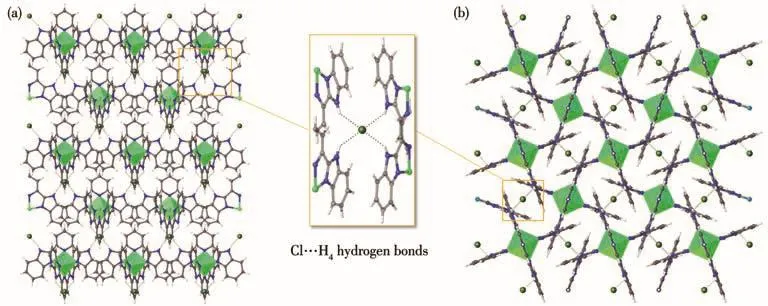
Fig.3 Portion of the packing crystal structure of 1 along with the(100)(a)and(001)(b)direction with a highligh of the Cl…H4 hydrogen bonds
2.2 PXRD and TGA
To check the purity of bulk material of 1,the PXRD experiment was performed.As can be seen in Fig.4a,the measured pattern at room temperature was nicely matched to the simulated pattern,indicating a pure phase of the bulk sample of 1.Additionally,TGA was performed to detect the thermal stability of 1.The resultant TGA curve revealed that the complex could be thermally stable up to ca.300℃(Fig.4b),where the complex began to decompose.This result is consistent with the crystal data,revealing high thermal stability of 1.
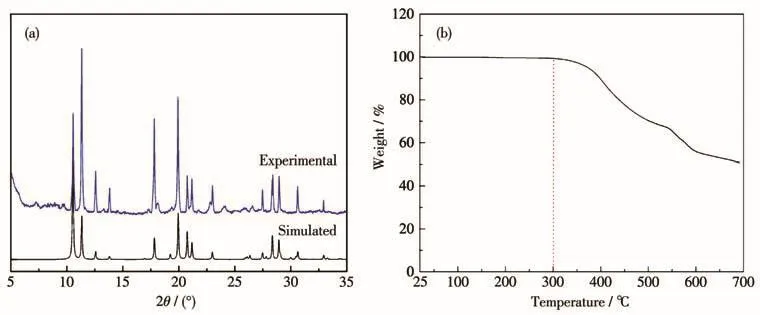
Fig.4 (a)Comparison of the experimental PXRD pattern of 1 with the simulated pattern;(b)TGA curve of 1
2.3 Magnetic properties
Temperature-dependent magnetic susceptibility was measured on the crystals sample of 1 to investigate the possible SCO behavior(Fig.5).The room temperature χMT value of 1 was 0.41 cm3·mol-1·K,indicating a low spin Fe3+at this temperature.The χMT value remains nearly constant at 310 K,suggesting a low spin state within this temperature range.However,with the temperature increasing to 330 K,the χMT value abruptly increased to 3.28 cm3·mol-1·K at 355 K,and gradually reached 4.09 cm3·mol-1·K at 400 K.The subsequent cooling mode indicated that the abrupt decreasing temperature was 340 K and the χMT value reached 0.41 cm3·mol-1·K at 325 K.Thus complex 1 exhibited an abrupt hysteretic SCO behavior with T1/2↑=345 and T1/2↓=330 K.The 15 K hysteresis loop indicates significant magnetic bistability for 1.

Fig.5 Temperature-dependent χMT curves of 1 under 1 kOe dc field,where the solid lines are guided for the eyes,and temperature-dependent χMT measured after irradiation with the 445 nm laser at 10 K
Furthermore,to quantitatively detect the cooperativity in 1,the regular solution model[26]was used to fit the magnetic susceptibility of 1 with the following equation(1):

where γHSis the molar fraction of HS state;R is the molar gas constant;ΔH and ΔS represent the enthalpy and the entropy variations;Γ is the parameter accounting for cooperativity associated with the spin conversion.The best fits afforded the data for the cooling and heating modes,respectively:ΔH=-15.3 kJ·mol-1,ΔS=-59.8 J·mol-1·K-1,and Γ=2.92 kJ·mol-1;ΔH=16.1 kJ·mol-1, ΔS=61.2 J·mol-1·K-1,and Γ =2.82 kJ·mol-1.These fitting parameters are comparable with the reported Fe2+/Fe3+SCO complexes.The obtained Γ values were positive and relatively large revealing that the[Fe(bzimpy-1H)2]+species are liable to be surrounded by molecules of the same spin states to achieve strong cooperativity.
To probe the possible light-induced excited spin state trapping(LIESST)effect of 1,photomagnetic measurement was also performed.After the sample was irradiated in the SQUID chamber by a 445 nm laser at 10 K,a sharp increase in the magnetization value was observed and the χMT value saturated to 3.03 cm3·mol-1·K at 28 K after 2 h of irradiation(Fig.5).This result suggests that the light-induced metastable HS*state is partly trapped by the excitation of FeⅢin the LS state.Upon heating,the χMT value dramatically decreased to 0.42 cm3·mol-1·K at 78 K,indicating a relatively fast relaxation of the metastable HS*state of the Fe3+ions.
2.4 X-band EPR measurement
To further probe the spin state and oxidation state of Fe ion at 300 K,the EPR spectrum was measured.The obtained EPR spectrum is shown in Fig.6,which exhibits sharp and strong peaks in the vicinity of the 3 000 G field.These EPR signals usually indicate a triplet-state(S=1/2)of the measured complex and are comparable with the characteristic peaks of LS Fe(Ⅲ)[27-28].The spectrum was further simulated by the EasySpin-EPR program,giving the anisotropic gtensors:gx=2.20,gy=2.07,and gz=1.94.These values were typical of those determined for the reported LS Fe3+complexes[29-30].Thus,the result is consistent with the crystal data and magnetic measurement.
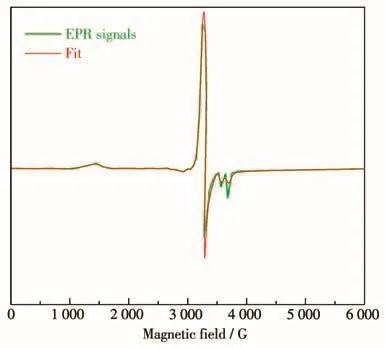
Fig.6 Solid-state EPR spectrum for complex 1
2.5 DSC measurement
To further probe the SCO transition behavior in 1,the DSC experiment was performed using a scan rate of 5 K·min-1(Fig.7).As depicted in Fig.7,a pair of notable sharp exothermic/endothermic peaks could be observed at ca.324 and 340 K during cooling and heating processes,respectively,indicating a hysteretic effect of about 16 K.These results agreed well with the SCO behavior observed in the magnetic measurements.The sharp peaks and thermal hysteretic effect reveal a first-order phase transition happening in 1 during the SCO process.The corresponding enthalpy(ΔH)and entropy(ΔS)values were integrated to be-11.5/13.1 kJ·mol-1and-50.3/51.7 J·mol-1·K-1for the cooling/heating processes,respectively.These results indicate that the spin transition shows a considerable contribution from the molecular vibrations.The observed values were comparable with the other FeⅢSCO complexes with abrupt hysteretic SCO and the fitted results via magnetic susceptibility data.
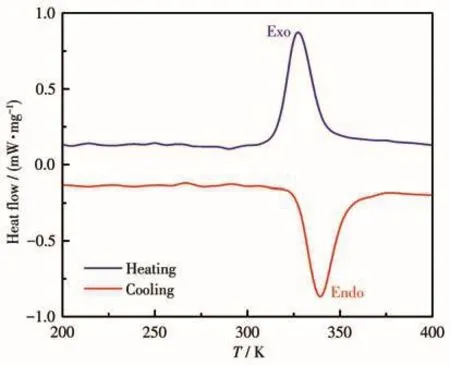
Fig.7 DSC results of 1 in three cooling and warming cycles with a scan rate of 5 K·min-1
2.6 Discussion
Based on the studies on Fe(Ⅱ)complexes con-structed by bzimpy,we can conclude that the stoichiometry of the complexes with the content of counter ions and solvates is variable[17-21].Their consequences on SCO behavior are significantly affected by supramolecular interactions,including hydrogen bonding networks,π-π stacking interactions,etc.These facts can be well illustrated by the[FeⅡ(bzimpy)2](ClO4)2·xH2O SCO system.When x=0.5,the complex exhibits a 12 K hysteretic SCO with T1/2=403 K while no hysteretic SCO with T1/2=424 K when x=2.Additionally,the counter ions are also critical.For instance,though the complex[FeⅡ(bzimpy)2](SO4)2·2H2O can show SCO behavior,the conversion is far from complete above 500 K.Notably,all the reported bzimpy-based Fe(Ⅱ)complexes contain lattice solvents.In fact,solvent-free systems are more attractive from the application perspective.The presented complex here is the first example of a bzimpy-based iron complex without solvent.The second distinct characteristic of complex 1 is its counter ions,which is a very simple single ion Cl-.In comparison,complex 1 is notable among the previously reported relative iron coordination compounds[16-21].
It has been widely realized that the effective supramolecular interaction in the SCO center is of great importance for cooperative SCO behavior.As two illustrative examples,weber et al.reported a Fe(Ⅱ)SCO complex showing a 69 K wide thermal hysteresis loop because of the formation of a 2D hydrogen-bonded network[31].Hayami and co-workers reported a Fe(Ⅲ)SCO complex that exhibits very wide thermal hysteresis loops(140 K in the first cycle and 70 K after the first cycle)originating from the 1D network structure induced by π -π interactions between quinoline and phenyl rings[32].In the presented complex 1,the Fe(Ⅲ)SCO molecules were well bridged by halogen hydrogen bonds via an interesting Cl…H4mode.To the best of our knowledge,such a halogen hydrogen bond is extremely rare[33].Thus,we think the halogen hydrogen bonds are a key factor contributing to the strongly cooperative spin transition in 1.In addition,the high thermal stability is also should be attributed to the halogen hydrogen bonded supramolecular structure.However,the high-temperature structure cannot be measured due to the drastic spin transition accompanying significant lattice motion,which prevents a detailed study of the structure transformation and lattice vibration during the SCO phase transition.
3 Conclusions
In summary,we describe a mononuclear Fe(Ⅲ)complex displaying above room-temperature SCO bistability.Single-crystal X-ray diffraction analysis revealed the Fe3+anions are bridged by N—H…Cl hydrogen bonds leading to an interesting halogen hydrogenbonded supramolecular structure.Magnetic studies indicated that the complex exhibited an abrupt spin transition with a significant 15 K thermal hysteresis loop and LIESST effect.The spin bistability was further established by the DSC experiment.The foregoing results suggest that the introduction of halogen ion and halogen-hydrogen bonding interactions in SCO complexes provides an alternative route for developing strong cooperative SCO materials.Further attempt to design and synthesize more halogen hydrogen-bonded Fe(Ⅲ)SCO complexes is currently underway in our lab.

